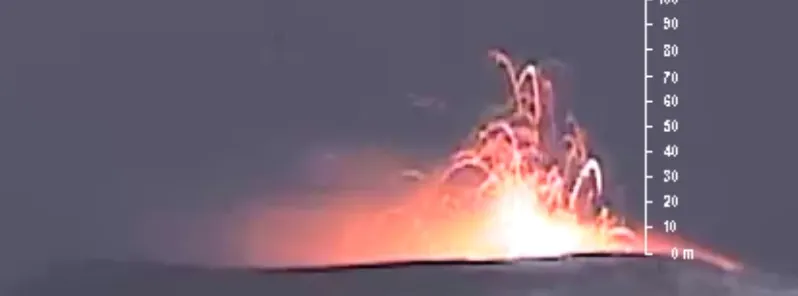Increased volcanic activity observed at Chile’s Villarrica volcano

Increased volcanic activity was detected at the Villarrica volcano in Chile, starting on September 24, 2023, prompting officials to elevate the alert level to Orange. Evacuations have commenced in affected communes, and educational institutions have been temporarily closed.
Increased levels of seismic and volcanic activity have been observed at the Villarrica volcano in the regions of Araucania and Los Rios, about 83 km (52 miles) southeast of Temuco, Chile. As a result, the National Geology and Mining Service of Chile (SERNAGEOMIN) has raised the alert level to Orange, the second-highest level on a four-tier scale. In addition to this, the National Office of Emergency of the Interior Ministry (SENAPRED) is maintaining a Yellow alert for the communes of Villarrica, Pucon, and Curarrehue in La Araucania Region and the commune of Panguipulli in Los Rios Region.
The security perimeter surrounding Villarrica has been expanded from 0.5 km (0.3 miles) to 8 km (5 miles), with the possibility of further revisions in the coming days.
Around 30 families residing between Villarrica and Pucon communes have been evacuated as a precautionary measure. Furthermore, the Ministry of Education (MINEDUC) has suspended classes in five schools in the Panguipulli Commune, effective from September 25. Additional eruptions could result in low-level seismic disturbances, ash clouds, and potential landslides in nearby areas.
#Volcanvillarrica La noche del 25 al 26, entre periodos de claridad, se observaron explosiones estrombolianas esporádicas. Las salpicaduras alcanzaron alturas máximas estimadas en 80 metros sobre los bordes del cráter, 40 metros menos que del 24 al 25. @SmithsonianGVP pic.twitter.com/WoS4ojyALh
— P.O.V.I. (@povi_cl) September 26, 2023
🚁🌋 En pronta respuesta a una solicitud de apoyo de @Senapred, nuestros pilotos de la JDN y personal técnico de @Sernageomin, sobrevolaron el volcán Villarrica para monitorear la situación, producto de la Alerta Naranja. #TrabajoInteragencial #SeguridadRegional #VolcánVillarrica pic.twitter.com/lPo8IOnIyl
— JDN ARAUCANÍA (@JdnAraucania) September 24, 2023
🔴⚠️🌋🇨🇱 This is the first satellite view of #Villarrica #volcano after declaring #AlertaNaranja for its renewed activity with explosions and seismic events. Here the latest #Landsat 8 image captured on Sept.24, with the snowy volcano and its highly hot crater. #chile #eruption pic.twitter.com/dWQlniE4uB
— SatWorld (@or_bit_eye) September 26, 2023
Actividad del #Volcán #Villarrica esta mañana en #Chile 🇨🇱
— Geól. Sergio Almazán (@chematierra) September 27, 2023
🌋
Continua emisión de gas y cenizas sobre su nevado y bello cráter.
Alerta Técnica Naranja
Septiembre 26 de 2023#VolcanVillarrica
Créditos 🎥 Eduardo Seguel pic.twitter.com/4J2pehqMnK
According to a bulletin released by SERNAGEOMIN on September 26, the volcanic system remains unstable. Though a slight decline in continuous seismic energy was observed in the 24 hours leading up to 15:00 local time, the values remain high. Incandescent material has been ejected near the crater in what are described as Strombolian explosions, and there was a continuous emission of ashes lasting approximately 50 minutes. The possibility of more explosive events occurring remains high, with risks including ballistic pyroclast ejection and potentially, flows of lava, mixed avalanches, pyroclastic flows, and lahars within an 8 km (5 miles) radius around the center of the crater.
As of the last available data on September 24, an average sulfur dioxide (SO2) flow of 1 097 t/d was measured. The equipment used for this measurement was installed 6 km (3.7 miles) east-southeast of the active crater and employed Differential Optical Absorption Spectroscopy (DOAS) for the readings.
References:
1 Reporte de Actividad Volcánica (RAV) – Red Nacional de Vigilancia Volcánica – Observatorio Volcanológico de los Andes del Sur – Ovdas – VILLARICA – September 26, 2023
2 Chile: Increased volcanic activity ongoing at Villarrica volcano in Araucania and Los Rios regions as of Sept. 24 – Crisis24 – September 25, 2023
Featured image credit: P.O.V.I.

Commenting rules and guidelines
We value the thoughts and opinions of our readers and welcome healthy discussions on our website. In order to maintain a respectful and positive community, we ask that all commenters follow these rules.